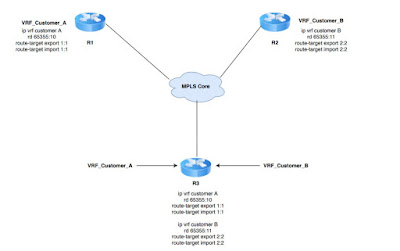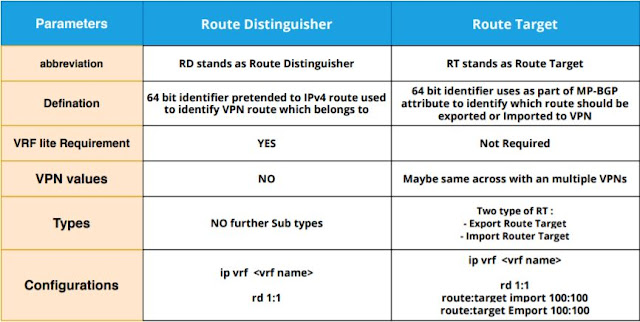Route Target is one of the extensive community of BGP which is used in MPLS networks. Before understading and knowing about the what is the Route Target?, you have to know some basic concepts as VRF, RD which is generally used in MPLS network. VRF ( Virtual route forwarding ) we discussed earlier in the post, Now the important term to understand is RT ( Route Target ) Used with RD and VRF.
 |
| MPLS Route Target |
First of all we are going to know about why RT (Route Target) used in MPLS networks, RT ( Route Target ) comes into the scene when you have multiple remote sites which is connected to MPLS. So there are two concepts of RT as an Import and export.
How and where to use Import and Export RT.
as with any VRF, When you configure RT import, it imports all the prefixes that matches the configured RT value as one of the attribute in the BGP update. So in any-any VRF, it is common to see all PE configured with same RT value (You may see more RT depending on inter-VRF scenarios).
Also RT is used to export the routes from one site and import at other side and vice versa. So by using import and export you can have the specific routes at the sites. It's the concept of the route filtering for specified site.
I have told earlier as an RT is a extensive community of 32 bit and the information regarding the RT will be sent by MP-iBGP protocol to all the PE's where customer sites are directly connected.
There is nothing as mandatory to use ASN as part of RD or RT. You can use XXX:YYY format. The use of ASN:XXX is useful from operational point of view.
Difference of RD and RT
Route Distinguisher (RD) separates routes (one VRF for each customer routing table) of one customer from another. RD is prepended to each route (64-bit identifier is prepended) within a VRF to identify which VPN the route belongs to. An RD is carried along with a route via MP-BGP when exchanging VPN routes with other PE routers.
Route Target is a 64-bit identifier used as part of MP-BGP attribute (extended community) to identify which route should be exported or imported to specific VPN.Whereas route distinguishers are used to maintain uniqueness among identical routes in different VRFs, route targets can be used to share routes among them. We can apply route targets to a VRF to control the import and export of routes.
While with an configuring the VRF lite, RD is mandatory to be configured, RT configuration may not be required. Additionally, Route target may be categorized into 2 types – Export Route target and Import Route target respectively.
 |
| Difference of RD and RT |
Comments
Post a Comment